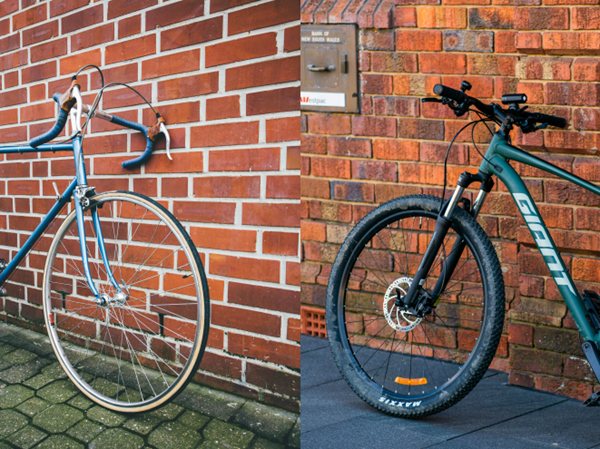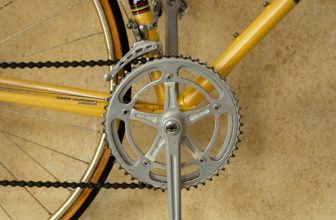Disc Brakes vs Rim Brakes

The great brake debate; whether you’re a road warrior, a trail shredder, or someone who just loves cruising, the question of disc versus rim brakes is bound to break into your cycling conversation.
Disc Brakes: The Stop-and-Go Lowdown
Disc brakes? Oh, you mean those things that make your bike look like it’s about to take on a downhill mountain stage of the Tour de France even if you’re just popping down to the shops? Yes, those! They’re relatively new to the scene (in bike years), but boy, have they made an entrance.
Pros:
- Weather Who? Disc brakes laugh in the face of adverse weather. Wet, muddy, snowy – they don’t care. The braking performance is consistently strong regardless of Mother Nature’s mood swings.
- Feather-Touch Braking: Smooth operation is the name of the game. You get great control over braking power, which is especially handy when you need to stop on a fifty pence piece or manage your speed on technical descents.
- Longevity: Those rotors and pads tend to last longer than their rim-brake cousins, mainly because they don’t get as dirty and aren’t directly wearing your rim down.
Cons:
- Heavier and Pricier: They add a bit of weight and can bump up the price tag of your bike.
- Maintenance Meets Learning Curve: If you’re the kind of cyclist who loves a good DIY project, disc brakes offer a satisfying challenge. Yes, there’s a learning curve, especially with hydraulic systems, but think of the skills you’ll acquire! You’ll be bleeding brakes and replacing pads like a pro in no time. On the flip side, if the idea of bike maintenance sends shivers down your spine, rim brakes’ simplicity will be more your speed. A quick pad change or adjustment is about as complicated as it gets.
Rim Brakes: The Classic Stop
Rim brakes are like that old band t-shirt you can’t throw away. They’ve been around the block, providing reliable stopping power by clamping onto the wheel’s rim.
Pros:
- Lightweight and Less Expensive: They keep your ride light and your wallet heavier. Plus, the initial cost is usually lower.
- Easy-Peasy Maintenance: Most cyclists can adjust and replace pads on rim brakes without having to watch a hundred YouTube tutorials.
Cons:
- Weather Woes: Rain or mud can reduce their effectiveness, making your braking experience more akin to a suggestion than an actual stop.
- Wear and Tear: Your rim is the braking surface, so over time, it wears down, which eventually means you’ll need a new wheel.
Safety Dance: Discs vs. Rims
Now, let’s get serious for a moment and talk safety. When the sky opens up or you’re descending a technical trail, disc brakes are your best bud. They offer consistent braking power in all conditions, and that control is key for not turning into a human missile.
For smooth braking operation, disc brakes, particularly hydraulic models, offer a more nuanced control over braking power, allowing for a gentler or stronger stop as needed. This is crucial when you’re trying to avoid obstacles or manage your speed on tricky descents.
What About the Kids?
When it comes to children’s bikes, the debate takes a bit of a turn. Rim brakes are often used for smaller bikes due to their simplicity and the fact that kids might not need the extra stopping power of disc brakes. They’re easier for little hands to operate and maintain. However, as kids’ bikes get more sophisticated (and as the little rippers get more adventurous), disc brakes are starting to pop up more frequently for their superior safety features, especially in wet conditions.
The Future of Braking
As technology advances, we’re seeing innovations in both disc and rim brake systems, making them lighter, more efficient, and easier to maintain. The cycling world is continually evolving, and who knows? We might be on the cusp of the next big breakthrough in braking technology.
Embracing Change and Tradition
As the industry leans towards innovation, disc brakes are becoming more common on all types of bikes, from high-end race machines to everyday commuters. This shift is a nod towards the increasing demand for versatility and performance in varied conditions. Yet, the continued presence of rim brakes in professional races and among cycling purists shows a deep-seated respect for tradition and the minimalist ethos of cycling.
Looking ahead, the future of cycling seems to be one of flexibility and choice. With advancements in technology, we might see lighter, more efficient disc brakes that appeal to weight-conscious road racers, or even more user-friendly maintenance solutions that make them accessible to all riders. Similarly, innovations in rim brake design could revitalize their appeal, offering enhanced performance that competes with the stopping power of discs.
The Learning Curve
For those new to cycling or considering switching brake types, the learning curve can seem daunting. Yet, just like mastering the art of shifting gears or fixing a flat tire, understanding and maintaining your braking system becomes second nature over time. Communities, online forums, and local bike shops are invaluable resources for demystifying disc brakes and making maintenance less of a chore and more a part of the cycling experience.
The Cost of Stopping
When weighing the costs of disc versus rim brakes, consider not just the price tag but the value they bring to your riding experience. Disc brakes might offer a safer, more reliable ride in wet weather or on demanding terrains, potentially avoiding accidents or damage to your bike. Rim brakes, with their simplicity and lower cost, might be the perfect fit for a casual rider or someone who sticks to well-paved roads and fair weather.
Initial costs aside, when you’re cruising on disc brakes, replacement parts can be a tad more expensive, and if you’re rolling with hydraulic discs, maintenance can get pricier due to the fluid and potentially needing professional help. Rim brake pads, on the other hand, are cheap as chips and easy to swap out.
But here’s the kicker: because rim brakes wear down the wheel rim, you might need to replace your wheels sooner than you’d like, which can be a significant expense. Disc brakes might be pricier upfront and for parts, but they could save you money in the long run.
Riding Your Own Ride
At the end of the day, the choice between disc and rim brakes is deeply personal. It’s about how you connect with your bike and the road (or trail) beneath you. Some riders will always gravitate towards the cutting-edge performance and all-condition reliability of disc brakes, while others will cherish the simplicity and elegance of rim brakes.
The beauty of cycling lies in its diversity – from the bikes we ride to the paths we choose to explore. Whether you’re gearing up for a gruelling mountain climb, navigating the urban jungle, or teaching a child to ride in the park, your brakes are more than just a mechanical choice; they’re part of your journey.








